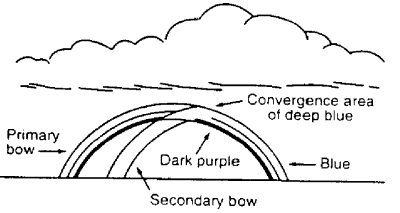 |
Science Frontiers ONLINE No. 124: Jul-Aug 1999 |
|
|
Offset Lunar Rainbow
May 13, 1998. South Atlantic Ocean. Aboard the m.v. Appleby enroute from Long Beach to Port Talbot.
"At 2225 UTC when a light rain shower was falling, a rainbow was seen on the starboard side roughly 2-3 cables from the vessel. It was very clear for about six minutes and was accompanied by a secondary bow after about half that time. The secondary one did not make a complete bow but seemed joined to the primary bow at its highest point, in a convergence area of deep blue, as indicated in the diagram.
"The colours were very clear, with blues and purples visible in both parts. Both bows began to fade at about the same time as the moon once again passed behind another cloud."
(Crofts, A.; "Lunar Rainbow," Marine Observer, 69:67, 1999.)
Comments. Because moonlight is much weaker than sunlight, lunar rainbows are rather rare. Even so, they are not anomalous. It is the offset bow that is difficult-to-explain. Rainbow phenomena should be symmetrical around the line containing the light source (moon, here) and the bow itself. In GEB3 in Rare Halos, we note that no reasonable explanation exists for rainbows offset to one side. However, extra bows offset directly above the main bow can be explained as due to reflection of moonlight or sunlight off the surface of the water.
